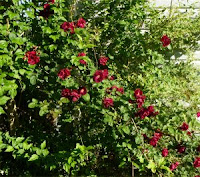Essential Oil Profile Outline
Common Name:
Fragonia ™ Referred to as
“coarse Tea Tree,” in the cut flower industry.
Latin binomial/family:
Agonis Fragrans originally but recently moved to the Taxandria
Genus and renamed Taxandria Fragrans as part of the Myrtaceae family.
(Closely related to Tea Tree, Rosalina, Niaouli, & Eucalyptus within the
Myrtle family of trees & shrubs.)
Note that the company that produces this unique oil still refers to it
as agonis fragrans in its literature & on its website.
Plant Description Origin:
A “fine leaved shrub,” growing to approximately 2.4 meters; found only in the Southwestern corner of Western Australia on the coast. (Unique in that the oil has been trademarked by Paperbark Oils due to the specific balance of this particular oil raised for its chemotype on a large plantation in Western Australia.)
Extraction Method: Steam distillation from the leaves & young branches.
Primary chemical constituents: 1.8 Cineole, Alpha-pinene, & linalool. Balanced in a near perfect 1:1:1 ratio of oxides (cineole), monoterpenes (alpha-pinene), & monoterpenols (linalool & other constituents), according to the producer, making it a unique oil.
Description (Oil & Aroma):
Color: Clear
Aroma: The aroma
is described as "a pleasant fresh cineolic odor with a hint of a citrus
note (which becomes more pronounced after a few minutes) mixed with a slight
spicy cinnamon tonality and sweet balsamic undertones. The dry down is very
faint being sweet, soapy and woody balsamic." (copyright Tony Burfield
2004). Less medicinal aroma than Tea
Tree.
Perfumery: Top Note
Chakras: Because
this is a relatively new oil, there is no specific information, however, a
Queensland aromatherapist/energy worker has experimented with the oil in her
practice, over a seven day period, having clients apply the oil to each of the
specific chakra points before sleep.
Subjects reported the upper chakras were more affected than the lower
chakras & felt an impact on their spirituality, dreaming, self awareness,
insight, & the ability to more easily resolve old issues. Additionally Dr. Daniel Penoel & Robbi
Zeck both report release of blockages by applying it to the tip of the spine
just below the neck before sleep.
Properties: Significantly antimicrobial. Also, anti-inflammatory, analgesic, antibacterial, antifungal, anti-infectious, decongestant, gentle expectorant, immune building,
Aroma-therapeutic Indications:
Body
Skincare: Non toxic & non irritating. Very gentle for use in skincare. Safe enough to use on children.
Respiratory: Excellent for use in sinus & respiratory infections, gently clearing lungs.
Immune system: Can be applied to lymph glands to boost immune system per Dr. Penoel. (neck, armpits, groin area)
Infections: Helpful for both bacterial & fungal infections. Case studies showing impact in fighting bacterial tonsillitis & staphylococcus aureus. Effective against Candida albicans. Synergistically said to work well with KunzeaAmbigua.
Pain Reliever: Indicated for arthritis, joint & muscle pain, as well as mild dental pain.
Mind & Spirit:
This is where Fragonia ™ shines.
Amazingly powerful effect on the mind & emotions. Thought to be a balancer of emotions. There are case studies of individuals using Fragonia ™ to release longstanding
emotional blockages bringing peace & harmony to the mind. Releases tension & can have a calming
effect on the mind.
In The Blossoming Heart, Robbi Zeck says, “Like a candle
carrying the light of dignity, Fragonia ™ is fertilizer for the spirit, taking
you beyond lingering hurts & emotional meshments stemming from any
unresolved family issues…” She further
states, “Fragonia ™ carries a unique energy pattern bringing the gift of the
power of love.”
Spiritually harmonizing & uplifting.
Safety Data & Precautions:
Non toxic & non irritant.
As with all essential oils, dilute for use on skin, however,
some sources, including Dr. Penoel, say it is safe to use it neat on lymph
nodes for immune building & others promote the use of it neat on chakras
for spiritual use.
References:
The Journal of Essential Oil Research (JEOR), July/August
2007, “Composition of an Essential Oil of Agonis fragrans,” by Lowe, Robert F.,
Russell, Michael F., Southwell, Ian A., Christopher, J, & Day, John.
Microbiology & Immunology, Volume 52, Issue 11, October
2008. “Antimicrobial &
anti-inflammatory activity of five Taxandria fragrans oils in vitro.” Hammer, Katherine A., Carson, Christine F.,
Dunstan, Janet A., Hale, Jasmine, Lehmann, Heidi, Robinson, Christopher J.,
Prescott, Susan L., & Riley, Thomas V.
“The Medicinal Essential Oil Awakening,” article by Sana Turnock of Joyful Living Consulting. www.aromacasa.com, 2011
www.paperbarkoils.com.au, John Day, 2011
www.naturesgift.com, Marge Clark, 2010
www.sunrosearomatics.com, Roseanne Tartaro, 2010
The Blossoming Heart, Zeck, Robbi, 2008, pages 80-81.
Teleconference text, Alliance of International
Aromatherapists, March 2007, “Breakthroughs with Fragonia & Kunzea
Essential Oils,” Penoel, Dr. Daniel.








